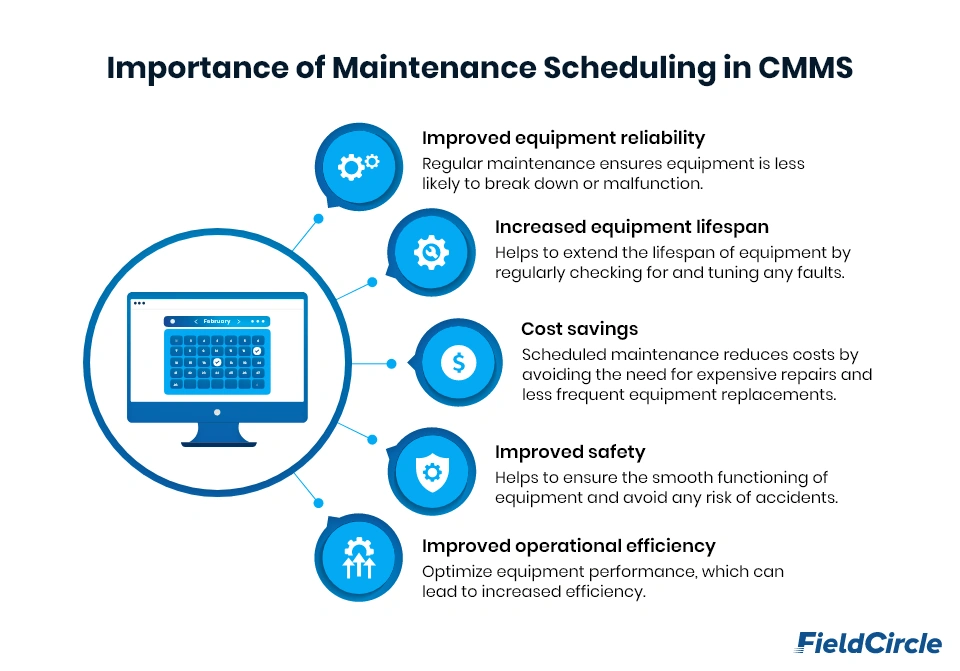10 Facility Maintenance Goals to Set for Your Department

I’m sure you’ve heard the saying, “The whole is greater than the sum of its parts.”
And it holds true in facility maintenance too. The results are remarkable when all the pieces of your department work together toward a common goal.
Imagine each part performing optimally, calibrated to work perfectly with the others. That’s when success becomes inevitable because each part’s strength contributes to the whole’s strength.
Whether you’re a leader or an employee, you must set goals for your facility maintenance team as it offers an opportunity to achieve extraordinary things. You start a new role as a facility manager, excited to make a difference. But without specific goals in place, you find yourself tackling tasks randomly, firefighting issues as they arise.
You realize your efforts lack direction and coordination, leading to inefficiencies and missed opportunities.
That’s why setting facility maintenance goals and objectives is essential, as without them managing a modern facility can become a nightmare. Goals provide focus and help in aligning team efforts with objectives and drive continuous improvement for your facilities maintenance management . They give you a clear vision of where you want to be and the steps needed to get there.
Here are the 10 Top Facility Maintenance Goals to Set For Your Facility Maintenance Department:
1. Increased Safety and Security
2.Optimized Energy Efficiency
3. Streamlined Maintenance Operations
4. Healthy Equipment
5. Space utilization
6. Sustainability
7. Comply with Regulations
8. Efficient Communication and Collaboration
9. Training and Development:
10. Tracking Progress Data
1. Increased Safety and Security
There’s no denying that safety and security should be a priority, as at the end of the day every facility team wants to ensure secure facility operations. It’s like putting on armor to shield your facility from potential threats. We all want peace of mind, knowing that our occupants are protected. So, in any enterprise, the objective of the facility safety team is to make sure that safety protocols are being adhered to, and each person works in a safe environment.
Now, let’s imagine this scenario: You’re the facility manager of a bustling office building, responsible for the well-being of hundreds of employees and visitors. One day, you receive news of a recent break-in at a neighboring facility, leaving you and your team concerned about the vulnerability of your premises.
The incident raises questions and sparks conversations among your colleagues:
- “Are our current security measures sufficient to prevent such incidents?”
- “Do we have an emergency response plan in place?”
- “How can we ensure the safety of our employees during critical situations?”
These questions highlight the facility management problem that needs to be addressed – the need for improved safety and security measures. It’s essential to fortify your defenses and proactively safeguard your facility and its occupants from potential risks.
Setting a goal for increased safety and security involves implementing various measures, such as enhancing access control systems, conducting regular safety inspections, implementing emergency response protocols, and training staff members on handling critical situations.
2. Optimized Energy Efficiency
Are you tired of soaring utility bills eating away at your budget? Do you often wonder how you can reduce energy consumption and create a more sustainable future?
As a facility manager, you face the challenge of balancing operational efficiency with cost savings while always dreaming of an energy-efficient facility. Energy expenses can quickly spiral out of control, impacting your bottom line and hindering your ability to invest in other crucial areas. That’s where optimized energy efficiency comes into play.
Let’s paint a picture to make this goal more tangible. Imagine a facility manager sitting in a meeting with stakeholders.
One person asks, “How can we reduce our energy costs and improve sustainability?”
Another chimes in, “What if we set an optimized energy efficiency goal to reduce our energy consumption by 20% within the next year? We can implement energy-saving measures, upgrade equipment, and engage employees in energy-conscious practices. Not only will this save us money, but it will also position us as leaders in sustainability.”
Setting an optimized energy efficiency goal like this demonstrates a commitment to both financial savings and environmental responsibility. Link energy efficiency with the aim to achieve annual financial goals. It drives change within your facility, sparking innovative ideas and encouraging everyone to play their part.
3. Streamlined Maintenance Operations
What do most facility managers want the most? It’s a smooth and efficient maintenance operation. That means things are going as per scheduled preventive maintenance activities.
Imagine this scenario: You’re a facility manager responsible for a large office building. The maintenance department constantly addresses repair requests, manages equipment inspections, and strives for implementing routine maintenance procedures.
However, operating costs are soaring, and you often deal with breakdowns and unexpected disruptions.
To tackle these challenges head-on, setting a streamlined maintenance operations goal focused on optimized energy efficiency becomes crucial.
A strong goal statement for this objective could be: “To reduce energy waste and maximize efficiency, our facility management system will prioritize digitization to overcome paperwork (e.g. digital processing of work orders), conducting regular energy audits, and educating staff members on energy-saving practices. We will keep upgrading facility management systems so as to accommodate the ongoing procedural and regulatory changes.”
By implementing energy-efficient practices, such as upgrading to energy-saving equipment, optimizing HVAC systems, and implementing smart lighting solutions, you can bring down energy consumption and as a result reduce maintenance costs significantly, thus building a sustainable facility.
4. Healthy Equipment
You walk into your facility one morning, ready to tackle the day’s tasks, only to find that a critical piece of equipment has malfunctioned. Panic sets in as you realize the impact it will have on your operations, productivity, and even your reputation. You frantically search for a solution, but the damage is done.
Now, let’s flip the script. What if you had a proactive maintenance and repair plan in place? What if you regularly inspected, serviced, and addressed potential issues before they became major problems? The result? Smooth operations, minimal disruptions, and peace of mind. This needs to be translated into one of the goals for maintenance technicians.
Healthy equipment is essential to improve overall facility management efficiency. By prioritizing equipment efficiency, you can avoid costly breakdowns, reduce downtime, and ensure the longevity of your equipment. Preventive maintenance for critical equipment such as HVAC systems and Fire suppression systems thus become an absolute necessity. Practices, such as regular inspections, lubrication, and timely repairs, become your key companions in maintaining facility equipment ever reliable.
And with the help of a robust facilities management software, you can create equipment maintenance schedules, track equipment performance, receive automated reminders, and streamline work order management.
So, how can you achieve goals such as this one? Start by creating a comprehensive maintenance schedule tailored to your specific equipment. Regularly assess the condition of your assets, address any identified issues promptly, and document the maintenance activities. Engage your facility management team members in the process, providing training on proper equipment handling and encouraging them to report any anomalies they notice.
5. Space Utilization
Space utilization is not just about maximizing the physical dimensions of your facility; it’s about optimizing the functionality and efficiency of every area. But with your space getting occupied with assets and processes, you must devise a facility management strategy that makes optimum use of the available space.
However, not each facility will have an ideal layout, and there will be challenges. What does a facilities department do in such a case? The short answer is convert space utilization from a mere activity to a goal. Setting space utilization as a goal allows you to create a work environment that fosters innovation, collaboration, and productivity.
Imagine a goal statement that sounds like this: “We will maximize our facility’s space by implementing flexible workstations, optimizing layout design, and eliminating underutilized areas. Our aim is to create a dynamic and inspiring work environment that promotes creativity, enhances teamwork, and boosts productivity.”
By setting space utilization as a goal, you empower yourself as a facility manager to rethink your facility’s layout, reimagine workspaces, and eliminate wasted areas. This goal allows you to create a work environment that meets the evolving needs of your organization, improves employee satisfaction, and maximizes operational efficiency.
6. Sustainability
Sustainability is not just one of the primary facility maintenance goals but it’s one of the key organizational goals nowadays. It’s not just about being environmentally friendly, but it also makes good business sense. You can address some key challenges facility management faces by embracing sustainable practices.
Think about the mounting waste in landfills or the rising energy costs that eat into budgets. sustainability practices offer solutions to these problems.
Imagine having a sustainability goal statement for your facility management department. It could be something like: “The primary goal of the corporate management team is to reduce energy consumption by 20% and divert 80% of waste from landfills within the next year.” Sounds ambitious, right? But with the right strategies and commitment, it’s achievable.
You can significantly impact the environment and our bottom line by reducing waste, optimizing energy usage, and embracing renewable resources.
7. Comply With Regulations
You’re a dedicated facility manager responsible for a bustling office building. Your days involve overseeing maintenance, managing vendors, and ensuring a smooth operation.
However, you often find yourself overwhelmed by the sheer number of regulations and requirements that must be met to keep your facility in good standing.
Compliance is not just a legal obligation; it’s a strategic goal that should be at the forefront of your facility maintenance efforts. It is one of the key facility manager responsibilities.
Strategic facilities management involves prioritizing compliance as a crucial goal for your facility’s success. It’s about following regulations and requirements to maintain a safe and secure environment.
Consider this goal statement: “Our facility’s goal is to comply with all applicable regulations and maintain a safe and secure facility environment for our employees and visitors.”
With this goal in mind, you can proactively address potential compliance issues, identify areas for improvement, and implement necessary changes. It’s about adopting a proactive approach to ensure your facility meets or exceeds all relevant regulations and standards.
8. Efficient Communication and Collaboration
Departments operate in silos, information gets lost in translation, and projects suffer from misalignment. It’s time to break down those walls and build bridges for seamless cooperation.
Picture this scenario: You oversee a facility with multiple departments, each with its responsibilities and objectives. Without enhanced and consistent communication and collaboration, chaos ensues.
Maintenance requests get lost in email threads, operations struggle due to miscommunication, and the facility’s overall efficiency takes a hit.
Now imagine a different scenario. You set a clear goal of enhanced and consistent communication and collaboration as a facility manager. Your goal statement sounds something like this: “Our department will prioritize open and transparent communication, fostering collaboration across teams to ensure seamless operations and exceptional service delivery.”
Integrated facility management takes it a step further. It’s about bringing all aspects of facility management together under one integrated approach.
With this goal in mind, you implement strategies such as regular team meetings, clear channels of communication, and collaboration tools to facilitate effective information sharing. The result? Increased efficiency, improved problem-solving, and a more cohesive and productive work environment.
9. Training and Development
The success of your operations relies heavily on the skills and knowledge of your maintenance staff. They are the backbone of your facility, ensuring everything runs smoothly and efficiently. And at the same time it is one of the key responsibilities of facilities managers.
But have you ever wondered if your team has the right tools and expertise to excel in their roles? Are they equipped to handle the ever-evolving challenges of facility maintenance?
Investing in training and development is the key to unlocking the full potential of your team. By prioritizing their growth and providing them with the necessary skills, you empower them to shine and achieve greatness.
It’s not just about ticking boxes or meeting compliance requirements; it’s about creating a culture of continuous improvement and setting your facility apart from the rest.
Imagine a facility where every member of your maintenance staff has received specialized training in the latest technologies, safety protocols, and facilities management best practices. They are confident and competent in their roles, capable of tackling any issue that comes their way. This is the power of training and development.
10. Tracking Progress Data
You face challenges such as maintaining optimal energy efficiency, ensuring smooth operations, and keeping occupants satisfied. It’s a complex puzzle that requires careful planning and execution.
Setting clear facilities management goals and key performance indicators (KPIs) for your office facility management department becomes your guiding compass. It helps you stay focused, measure success, and identify areas for improvement. But always set realistic performance goals, to evaluate that you are marching in the right direction.
Tracking progress towards these operational and strategic goals enables you to monitor your department’s performance, make data-driven decisions, and take corrective actions when necessary. It empowers you to proactively address issues, optimize resources, and celebrate milestones along the way.
Conclusion
Remember, “The beauty of setting facilities department goals is not just in achieving them but in the process of growth and self-improvement along the way.” So, as we wrap up, let’s reflect on the significance of these goals. Conduct regular maintenance by keeping these goals in mind.
They aren’t just checkboxes to mark; they’re the stepping stones to excellence and pillars to build a long-term strategic plan. So, embrace the spirit of innovation, keep an eye on the big picture, and always seek ways to enhance the facility experience.
With the right mindset, dedication, and help from FieldCircle, you can make a lasting impact on facility maintenance.
Let’s strive for greatness and set new standards for ourselves and our departments. Together, we can create facilities that meet and exceed expectations.


